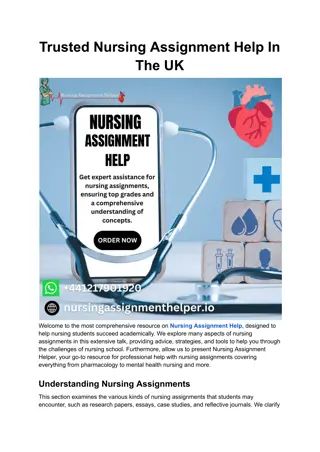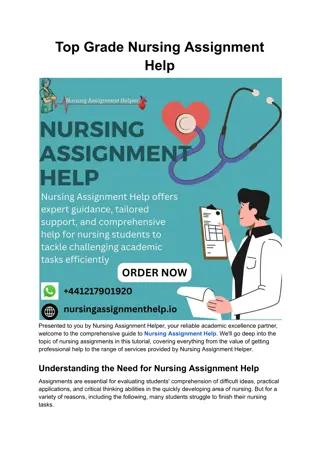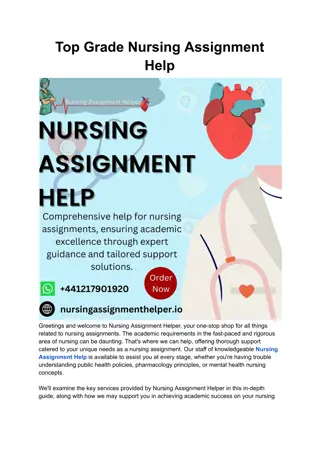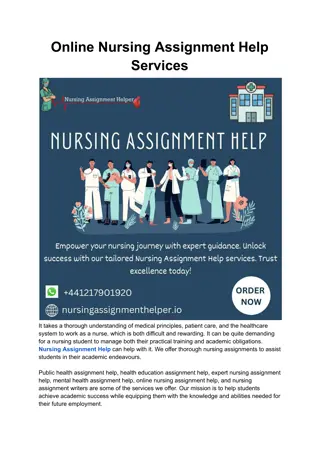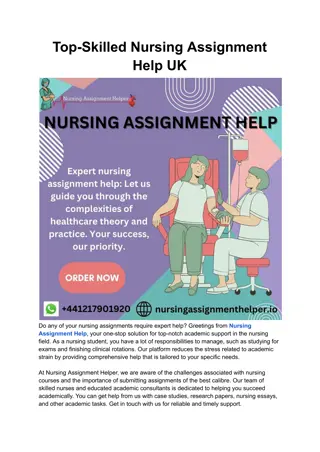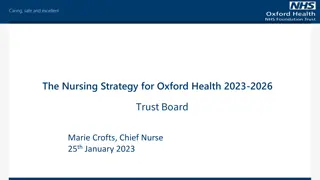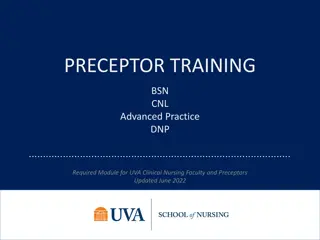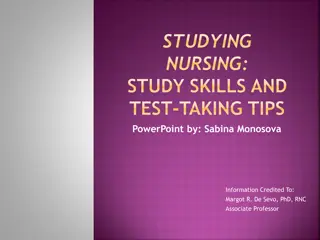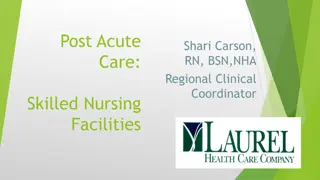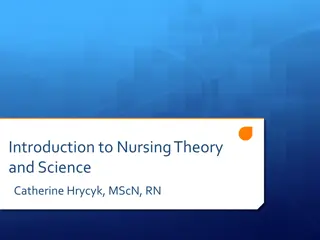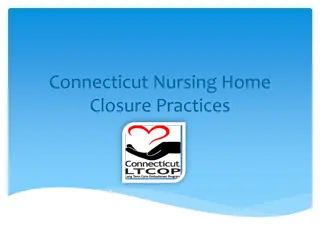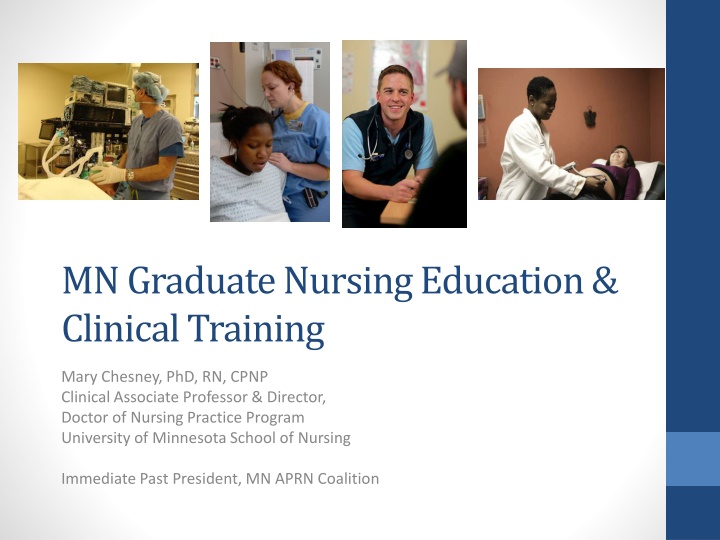
Evolving Landscape of Graduate Nursing Education and Clinical Training
Explore the world of Graduate Nursing Education (GNE) through the lens of different nurse roles, degree categories, and APRN acronyms. Delve into the various programs offered in Minnesota and the transition from Master's to Doctoral degree preparation in the field. Discover the key elements shaping the future of nursing education and clinical training.
Download Presentation

Please find below an Image/Link to download the presentation.
The content on the website is provided AS IS for your information and personal use only. It may not be sold, licensed, or shared on other websites without obtaining consent from the author. If you encounter any issues during the download, it is possible that the publisher has removed the file from their server.
You are allowed to download the files provided on this website for personal or commercial use, subject to the condition that they are used lawfully. All files are the property of their respective owners.
The content on the website is provided AS IS for your information and personal use only. It may not be sold, licensed, or shared on other websites without obtaining consent from the author.
E N D
Presentation Transcript
MN Graduate Nursing Education & Clinical Training Mary Chesney, PhD, RN, CPNP Clinical Associate Professor & Director, Doctor of Nursing Practice Program University of Minnesota School of Nursing Immediate Past President, MN APRN Coalition
Presentations Definition of GNE GNE = graduate nursing education in the generic sense & doesn t relate to a formal funding mechanism Differentiated from GME (Graduate Medical Education) a formal Medicare-sponsored funding mechanism for graduate medical education NOTE: ACA mandated pilot GNE funding grant 5 U.S. Hospitals (and affiliated APRN programs) First time in 47 years Medicare is supporting APRN education
GNE Categories by Nurse Role Traditional Advanced Practice Registered Nurse (APRN) Clinical Nurse Specialists (CNSs) Nurse Midwives (NMs) Nurse Practitioners (NPs) Registered Nurse Anesthetists (RNAs) Programs other than APRN Nursing administration/leadership Nursing Education Informatics Public Health Integrated Health & Healing
GNE Categories by Degree GNE continues to evolve; moving from Master s to Doctoral degree preparation Prerequisite for admission to either degree is a minimum of a bachelor s degree in nursing Master s Degree 2 years Doctor of Nursing Practice (DNP) Degree Initiated in 2006 3 to 4 years (about 8 -9 semesters)
APRN Acronym Key A/GNP A/GCNS FNP RNA NM PCNS PMHNP PNP WHNP Adult/Gerontology Nurse Practitioner Adult/Gerontology Clinical Nurse Specialist Family Nurse Practitioner Registered Nurse Anesthetist Nurse Midwife Pediatric Clinical Nurse Specialist Psych-Mental Health Nurse Practitioner Pediatric Nurse Practitioner Women s Health Nurse Practitioner
Minnesotas Graduate APRN Programs 1. Augsburg FNP (DNP degree) 2. Bethel NM (MS degree) 3. College of St. Scholastica ACNS, A/GNP, FNP, PMHNP (DNP degree) 4. Mayo School of Health Sciences RNA (MNAP DNAP) 5. Metropolitan State University FNP (DNP degree) 6. Minneapolis School of Anesthesia/St. Mary s U RNA (MS) 7. MN State University-Mankato FNP (MS degree) 8. St. Catherine University A/GNP, PNP (MS degree); option to earn DNP degree) 9. University of MN A/GNP, FNP, PNP, PMHNP, WHNP; RNA, NM, A/GCNS, PCNS (DNP degree) 10. Winona State University A/GNP, Acute A/GNP, FNP (MS degree; option to earn DNP degree)
MNs Graduate Primary Care APRN Programs MN School A/GNP FNP PNP WHNP NM Augsburg College X Bethel University X College of St. Scholastica X X Metropolitan State University X Minnesota State University - Mankato X St. Catherine University X X University of Minnesota X X X X X Winona State University X X
MNs Graduate Acute Care/MH APRN Programs MN School Acute Care A/GNP A/G CNS Nurse Anesthesia Peds CNS Psych MH NP College of St. Scholastica X X Mayo School of Health Sciences X Minneapolis School of Anesthesia (St. Mary s) X University of Minnesota X X X X Winona State University X X
MNs Other Graduate Nursing Programs MN School Admin/ Leader Ed Integrative Health Informatics Public Health Trans- Cultural Nsg. Augsburg College X Bethel University X X MN State U - Mankato X St. Catherine University X University of Minnesota X X X X *Certificate (non-degree) Program Winona State University X X
MNs Primary Care APRN Grads 2012-13 School A/GNP FNP NM PNP WHNP Total Augsburg (15/yr) - New 2013 - - - 0 Mankato - 34 - - - 34 Metro St - 24 - - - 24 St. Catherine 99* St. Scholastica 16 27 - - - 43 U of MN 9 16 6 5 8 44 Winona 2 10 - - - 12 Totals 256
APRN Requirements for Practice Role & Pop - Focused Clinical Training Hrs = 500 to 1,000+ State APRN Licensure (As of January, 2015) National Board Certification in Role & Specific Population Focus Graduate Nursing Education Master s or DNP Degree Clinical Practice as an RN Registered Nurse License Minimum of Bachelor s Degree in Nursing BSN Clinical Training Hrs = Min. 500+ 4 yrs. BSN + 2-3 yrs. MS/DNP = 6+ Years of Academic & Clinical Preparation
APRN Clinical Hours Determined by a number of entities Accrediting bodies Certification bodies American Association of Colleges of Nursing National Task Force (NP) Competency-based components may extend clinical hours MN Schools Master s programs - minimum of 500 hours (MN avg. of 600 hours) 1:1 preceptor-supervised, role and population-focused direct provider clinical hours DNP programs - minimum 1,000 hours About 650 to 800+ hours of 1:1 preceptor-supervised, role and population-focused direct provider clinical hours 200 to 400+ hours of systems-focused clinical hours (QI projects, IPECP leadership initiatives)
U.S. & MN APRN Data MN August 2014 U.S. 2014 APRN Role # in U.S. APRN Role # in MN CNSs 70,000 CNSs 554 NMs 13,071 NMs 287 NPs 192,000 NPs 3,969 RNAs 39,000 RNAs 1,647 TOTAL 314,071 TOTAL 6,457
GNE APRN Clinical Training Clinical training days are integrated into didactic education Students are assigned to a specific clinical site and preceptor (MD or APRN) for a semester RNA student is assigned to surgery department & works with a CRNA or MDA NP student is assigned to an NP or MD/DO at an urban, suburban, or rural clinic) NM student assigned to NM and practices both in clinic setting and in birthing center or hospital L & D CNS student assigned to CNS in hospital unit Variety of rotations planned across time to expose students to racial/ethnic/SES/geographic diversity Typical full-time student APRN school week: 36 to 40 hours of didactic course work (courses plus homework) 16 hours (two 8-hour days) clinical training
GNE APRN Clinical Training Other than limited MERC funding to qualifying clinical sites, there isn t a funding mechanism for APRN clinical training Preceptors and clinical facilities precept APRN students on a volunteer basis (exception emergence of preceptor payments from out-of-town online NP programs) CMS oversight and charting requirements that limit provider productivity cause reluctance to precept APRN students Requirements are more onerous for staff working with APRN or medical students than those working with residents who are already licensed
Clinical Training Sites Urban, suburban, rural out-patient clinics (pediatric, internal medicine, family practice, women s health, OB-Gyn) Urgent care & retail clinics Urban, suburban, and rural hospitals (surgical suites, L & D, patient-care units, ED) Ambulatory surgery centers Transitional care units, long-term care facilities, and home care agencies
APRN Student Numbers & Sites Needed U of MN utilizes over 250 clinical sites per semester 180 NP primary care, LTC, or TCU sites 16-20 CNS in-patient sites 10-14 NM sites (clinics and L & D or birth center sites) 36 NA sites
Estimate of MN Needed APRN Sites per Semester Psych-MH NP sites = 40 to 50 per semester Primary Care NP sites needed per semester = 400 to 450 per semester Biggest demands FNP sites = 235 to 245 per semester (6 FNP programs in MN) A/GNP sites = 130 to 140 per semester (3 A/GNP programs in MN) Numerous out-of-state online FNP programs add to these numbers Nurse midwife sites = 50 per semester Nurse anesthesia sites = 160 to 165 per semester Clinical nurse specialist sites = 50 to 60 per semester TOTAL APRN Clinical Training Sites per Semester = 700 to 775* (* Missing Winona State s Acute-Care A/GNP numbers)
Challenges & Issues No federal funding mechanism for clinical training of APRNs Onerous CMS regulations for medical and APRN students result in decreased productivity & revenue in current fee-for- service reimbursement structure Proprietary out-of-state online schools are starting to pay for preceptors/sites; many implications to consider Increasing Twin Cities & Rochester competition for primary care sites (Med, PA, APRN)
Challenges & Issues Placing & supporting APRN clinical students in greater MN is currently challenging As of 2013, there are 28 unfilled faculty vacancies in Minnesota (American Association of Colleges of Nursing, 2014) Faculty shortages continue to rise; majority of today s nursing faculty members will retire within the next 10-15 years; we do not have adequate DNP or PhD degree nurses in the pipeline Nursing faculty salaries are not competitive with practice salaries; disincentive to teach
Challenges & Issues APRN workforce doesn t represent MN s racial/ethnic diversity Working to recruit students of color; best demographic representation in nursing currently resides in A.D. nursing programs Race or Ethnicity Minnesota (2013)* MN APRNs (2011-12)** American Indian 1.3% 0.4% Black or African American 5.7% 1.7% Asian 4.5% 1.8% Multiple Races 2.3% 1.2% Other 0.1% 0.8% White or Caucasian 86.2% 94% Hispanic or Latino 5.0% 0.8% *Data from 2013 U.S. Census **Data from MDH ORHPC 2011-12




